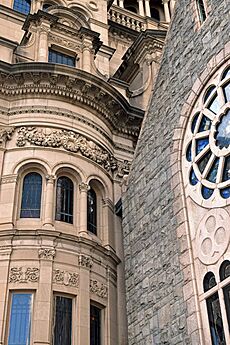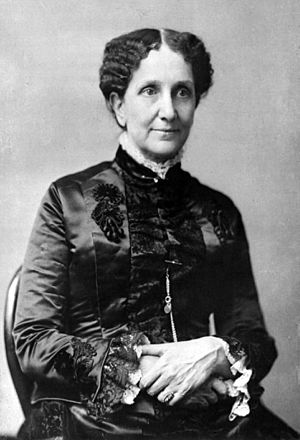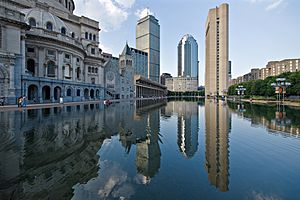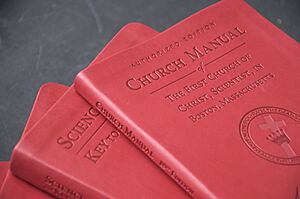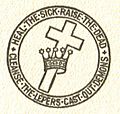Christian Science facts for kids
Quick facts for kids Christian Science |
|
|---|---|
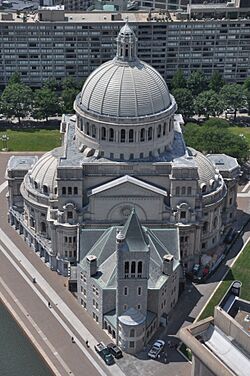
The First Church of Christ, Scientist at the Christian Science Center in Boston with the original Mother Church (1894) in the foreground and the Mother Church Extension (1906) behind it.
|
|
| Scripture | Science and Health with Key to the Scriptures by Mary Baker Eddy and the Bible |
| Theology | "Basic teachings", Church of Christ, Scientist |
| Founder | Mary Baker Eddy (1821–1910) |
| Members | Estimated 106,000 in the United States in 1990 and under 50,000 in 2009; according to the church, 400,000 worldwide in 2008. |
Christian Science is a set of beliefs and practices. These are followed by members of the Church of Christ, Scientist. People who follow Christian Science are often called Christian Scientists. The church was started in 1879 in New England by Mary Baker Eddy. She wrote a book in 1875 called Science and Health with Key to the Scriptures. This book explains the main ideas of Christian Science.
This book became a very important text for Christian Scientists. It is studied alongside the Bible. By 2001, over nine million copies of the book had been sold.
Mary Baker Eddy and 26 followers officially started the "Church of Christ (Scientist)" in 1879. Later, in 1892, it was reorganized as the "Church of Christ, Scientist." The main church, called The First Church of Christ, Scientist, was built in Boston, Massachusetts, in 1894. Christian Science grew quickly in the United States. By 1936, it had almost 270,000 members. However, by 2009, the number of members had decreased. The church is also known for its newspaper, The Christian Science Monitor. This newspaper has won several awards for its journalism. The church also has public Reading Rooms around the world.
Christian Science has some different beliefs compared to many other Christian denominations. These differences include ideas about the Trinity, the nature of Jesus, and the resurrection. Mary Baker Eddy believed Christian Science was a return to early Christian teachings. She felt it brought back the idea of healing through faith. Followers believe that reality is spiritual. They see the material world as less real or even an illusion. This means they believe sickness is a mental error, not a physical problem. They think prayer, not medicine, can heal by correcting wrong beliefs.
The church does not forbid medical care. Many members visit dentists, optometrists, and doctors for broken bones. They also get vaccinations if required by law. However, they believe Christian Science prayer works best when not mixed with medicine. This focus on prayer and avoiding medical treatment has caused some debate. Between the 1880s and 1990s, some parents faced legal issues. This was due to their reliance on prayer for serious illnesses.
Contents
Understanding Christian Science
A Different Way of Thinking
Christian Science is part of a group of religious movements. These groups became popular in the late 1800s in the United States. They are sometimes called the "metaphysical family" or "New Thought." These groups believed in the power of the mind. They thought that mental states could affect physical things. They often said that "God is mind" or "life is consciousness."
These groups focused a lot on healing. They believed that sickness came from "wrong thinking." They thought connecting with a "Divine Mind" could bring health. One early healer was Phineas Parkhurst Quimby. He believed that understanding a patient's thoughts could lead to healing. Mary Baker Eddy was one of his patients. There has been discussion about how much of Christian Science came from his ideas.
Christian Science is different because Mary Baker Eddy saw her ideas as a special, complete truth. She also believed that bad thoughts from others could cause harm. This idea is called "malicious animal magnetism." Most importantly, she taught that the material world is an illusion. This led her to reject medicine. This made Christian Science stand out from other similar groups. For Eddy, only the spiritual world was truly real.
Core Beliefs of Christian Science
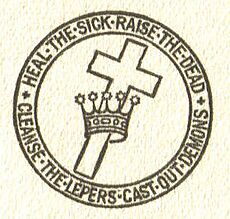
Christian Science leaders say their religion is part of mainstream Christian teaching. Mary Baker Eddy was influenced by her Congregationalist background. Christian Scientists believe in the Bible as their guide. They worship one supreme God. They also believe in God's Son, Christ, and the Holy Spirit.
Mary Baker Eddy wanted to bring back "primitive Christianity and its lost element of healing." She also suggested that Christian Science was like a second coming of spiritual understanding. She saw her book, Science and Health, as an inspired text. In 1895, she declared that the Bible and Science and Health would serve as the "Pastor" for the Mother Church.
Christian Science beliefs are different from traditional Christianity in some ways. Eddy's Science and Health reinterprets ideas like the Trinity and the crucifixion. She added a glossary to her book to redefine Christian words. A main idea is that the spiritual world is the only reality and is completely good. The material world, with its problems, is seen as an illusion. Eddy believed humans are a "perfect, eternal" idea of God. What she called "mortal man" is just a mistaken view of ourselves.
Eddy saw God not as a person, but as "All-in-all." She used terms like "Father–Mother God." God is often described in Christian Science using words like "Mind, Spirit, Soul, Principle, Life, Truth, Love." The Holy Ghost is Christian Science itself. Heaven and hell are seen as states of mind.
Christian Science prayer is a silent process. It involves affirming the unreality of matter. Christian Science practitioners can do this for others, even from a distance. Healing in Christian Science is seen as realizing that there is nothing truly to heal. It is believed to prevent illness and misfortune. If healing does not happen, it is thought to be due to an individual's own thoughts.
Eddy accepted the creation story in the Book of Genesis up to a certain point. She believed God created man in His image. But she rejected the rest of the story as "false and material." Her beliefs are nontrinitarian. She saw the Trinity as suggesting multiple gods. She viewed Jesus as a "Way-shower," showing humanity how to connect with God. She separated Jesus the man from the concept of Christ, which means Truth. The crucifixion was not seen as a sacrifice for sins. Instead, atonement was an "at-one-ment" with God. Her ideas about life after death were not very detailed. She believed individuals continue to learn after death.
Some traditional Christian leaders saw Eddy's ideas as a challenge to the Bible. Christian Science was sometimes called a "cult." Some Christian Scientists were even removed from their churches. Ministers worried when their members chose to leave. In 1885, a newspaper reported that many church members were joining Christian Science. Mark Twain wrote about Christian Science in 1907. He noted that followers felt it brought them joy and peace. They believed it was the true Christianity, rediscovered by Mrs. Eddy.
History of Christian Science
Mary Baker Eddy's Journey
Mary Baker Eddy was born Mary Morse Baker in New Hampshire. She was the youngest of six children. Her family was religious. She had little formal schooling but read a lot at home. She also had private tutors. From a young age, she often had poor health. Her first husband died shortly after they married. She was left without money. Because of her poor health, she lost custody of her son when he was four. She married again, but her new husband did not help her regain custody. Her son was taken to Minnesota.
Eddy tried many different cures for her health problems. These included traditional medicine and other methods. She tried homeopathy and mesmerism with Phineas Quimby. Critics later said she borrowed ideas from Quimby. This became a big debate in her life.
In February 1866, Eddy fell on ice in Massachusetts. She seemed to have serious injuries. But a few days later, she reportedly asked for her Bible. She read about one of Jesus' miracles. Then, she got out of bed, telling friends she was healed through prayer. She saw this moment as a key step in understanding Christian Science.
After her fall, Eddy began teaching her first student. She also started writing down her ideas. These ideas were published in Science and Health with Key to the Scriptures. This is considered her most important work. Her students decided to form a church in 1879. It was called the Church of Christ (Scientist). Later, it became The First Church of Christ, Scientist, or The Mother Church, in 1892. She also started the Massachusetts Metaphysical College in 1881 to teach more students.
Eddy also started several publications. These included The Christian Science Journal in 1883 and Christian Science Sentinel in 1898. In 1908, she founded The Christian Science Monitor, a newspaper. The Monitor has won many awards for its reporting. She also wrote other books and articles. The Manual of The Mother Church contained rules for the church. She founded the Christian Science Publishing Society in 1898. This was to share Christian Science writings. The first church building was built in Wisconsin in 1886. During Eddy's life, Christian Science spread across the United States and to other countries.
Mary Baker Eddy faced a lot of opposition. This increased as she got older. Mark Twain wrote several articles criticizing her and Christian Science. These were later published as a book. Other criticisms also appeared in magazines and books. In 1907, some of Eddy's relatives filed a lawsuit. They claimed she was not mentally able to manage her affairs. This was called the "Next Friends Suit." However, the suit failed. Eddy was interviewed by a judge and doctors. They concluded she was mentally competent. These criticisms partly led Eddy to start The Christian Science Monitor. She wanted a platform for responsible journalism.
Eddy passed away on December 3, 1910, at age 89. The church announced her passing. Her estate was worth $1.5 million. Most of this was left to the church.
Christian Science After 1910
After Eddy's death, some newspapers thought the church would disappear. But the movement continued to grow for several decades. The church's rules do not allow it to publish membership numbers. However, a 1936 study counted about 268,915 Christian Scientists in the U.S. The number of Christian Science churches kept growing until around 1960. Since then, many churches have closed. The number of Christian Science practitioners also began to decline in the 1940s. By 1972, there were over 3,200 churches worldwide. About 2,400 of these were in the United States.
The church has faced challenges and disagreements since Eddy's death. There were attempts to make Christian Science practice illegal in some places. There were also lawsuits about how the church was run. The church faced difficulties in countries like Germany and Japan during certain historical periods. There have been lawsuits concerning the deaths of church members, especially children. In 2023, the church withdrew a controversial book from publication. From its beginning, Christian Science has faced criticism. Some groups have called it a cult. Despite these challenges, many Christian Science churches and Reading Rooms still exist. There have been reports of the religion growing in Africa recently. The Christian Science Monitor remains a respected newspaper. It is known for its international news and fair reporting.
Healing Practices
How Christian Science Prayer Works
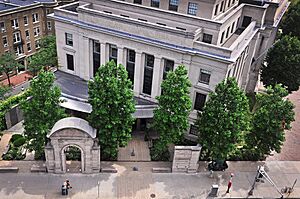
Christian Scientists often choose Christian Science prayer instead of medical treatment. This prayer is done silently. It does not involve asking a personal god for things. There are no specific words to say. A practitioner might silently repeat ideas about God. These ideas include that God is Life, Truth, Love, Spirit, Soul, Principle, and Mind. They might affirm that Spirit is the only reality. They might also deny the existence of evil or illness. The prayer ends by stating that disease is not real. This is believed to be God's word, which has healing power.
Christian Science practitioners are certified by the church. They charge a fee for Christian Science prayer. In 2015, there were 1,249 practitioners worldwide. In 2010, they charged $25–$50 for a consultation. Their training is a two-week course. There are also Christian Science nursing homes. These homes do not offer medical services. The nurses are Christian Scientists. They have religious training and basic care skills.
The Christian Science Journal and Christian Science Sentinel publish stories of healing. These stories are called testimonials. They must be supported by three people who know the person well. These people must have seen the healing or can confirm the person's honesty. Some experts say these stories do not prove healing. This is because some conditions get better on their own. Also, only positive stories are published.
A church spokesperson said in 1983 that members can choose medical care. However, some former members say those who do might feel left out. In 2010, church leaders said they were encouraging members to see a doctor if needed. They were also presenting Christian Science prayer as a support to medical care. The church has also worked to have Christian Science practitioner services covered by insurance.
In 2015, Christian Scientists in Australia were not advising against vaccines. The church stated that vaccination is a personal choice. They said the church does not forbid it.
The Church of Christ, Scientist
How the Church is Organized
The main church in Boston is called The First Church of Christ, Scientist. It is the only one that uses "The" in its name. Other churches in cities are named First Church of Christ, Scientist, then Second Church, and so on. For example, Third Church of Christ, Scientist, London. If a church closes, the others in that city keep their original names.
The Church of Christ, Scientist was founded in April 1879. It is led by a president and a five-person board of directors. There is a public relations department. It is called the Committee on Publication. This department has representatives around the world. Mary Baker Eddy set it up in 1898. Its job is to protect the church's reputation. In the 1990s, the church was accused of stopping internal criticism. This included firing staff and removing members.
The church's main offices are in Boston. They are located at the Christian Science Center. This large area includes the Mother Church (1894) and its Extension (1906). It also has the Christian Science Publishing Society building (1934). This building houses the Mary Baker Eddy Library. There is also a Sunday School building (1971) and an Administration Building (1972). The center also features a children's fountain and a large reflecting pool.
Church Rules and Guidelines
Mary Baker Eddy's Manual of The Mother Church (first published 1895) contains the church's rules. Members are required to pray daily. They must also study the Bible and Science and Health every day. Members should subscribe to church magazines if they can afford them. They also pay a small annual fee to the church.
The rules forbid certain actions. These include practicing "mental malpractice." This means using bad thoughts to harm others. Members cannot join other churches. They also cannot publish articles that are unkind to religion, medicine, or the law. The manual also says not to publish the number of church members. It also forbids public debates about Christian Science without approval. It includes a rule called "The Golden Rule." This rule asks members not to bother Mrs. Eddy when she goes out.
Church Services
The Church of Christ, Scientist is a lay church. This means it does not have ordained clergy or special rituals. It does not perform baptisms. Clergy from other faiths often perform marriage or funeral services. The main religious texts are the Bible and Science and Health. Each church has two Readers. They read aloud from these texts during Sunday services. They also read shorter selections at Wednesday evening meetings. During Wednesday meetings, members share stories. These often include healings they believe came from prayer. Services also include hymns, silent prayer, and reciting the Lord's Prayer.
Well-Known Christian Scientists
Many notable people have been Christian Scientists. These include government officials like William H. Webster and Stansfield M. Turner. Nancy Astor was a Christian Scientist. She was the first woman to be a member of the British Parliament. Other members of Parliament were also Christian Scientists. Charles Lightoller, who survived the sinking of the Titanic, was a member. Other famous people include businesswomen Martha Matilda Harper and Bette Nesmith Graham.
In sports, Harry Porter and George Sisler were Christian Scientists. Many actors and entertainers have also been members. These include Carol Channing, Jean Stapleton, Doris Day, George Hamilton, Mary Pickford, and Ginger Rogers. Some people were raised by Christian Scientists. These include Ellen DeGeneres, Henry Fonda, Audrey Hepburn, Marilyn Monroe, and Robin Williams.
Christian Science Publishing Society
The Christian Science Publishing Society publishes several magazines and newspapers. This includes The Christian Science Monitor. This newspaper has won seven Pulitzer Prizes. In 1970, it had a daily circulation of 220,000 copies. By 2008, this had dropped to 52,000. In 2009, it mostly moved online. It now has a weekly print edition. In the 1980s, the church made its own TV shows. In 1991, it started a 24-hour news channel. This channel closed after 13 months due to financial losses.
The church also publishes the weekly Christian Science Sentinel. It publishes the monthly Christian Science Journal. And it publishes Herald of Christian Science, which is in other languages. Since 2012, old issues of these publications are available online for subscribers.
Works by Mary Baker Eddy
- Science and Health with Key to the Scriptures (1875)
- Christian Healing (1880)
- The People's Idea of God: Its Effect on Health and Christianity (1883)
- No and Yes (1887)
- Unity of Good and Unreality of Evil (1888)
- Retrospection and Introspection (1891)
- Christ and Christmas (1893)
- Rudimental Divine Science (1894)
- Manual of The Mother Church (1895)
- Pulpit and Press (1895)
- Miscellaneous Writings, 1883–1896 (1897)
- The Christian Science Hymnal (1898)
- Poems (1910)
Images for kids
See also
 In Spanish: Ciencia cristiana para niños
In Spanish: Ciencia cristiana para niños
- Faith healing
- New religious movement
- New Thought
- Principia College



